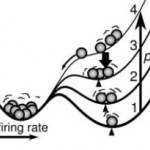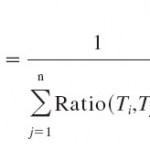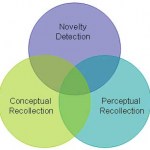Computational Modeling
Stimulating the brain with high frequency electrical noise can supersede the beneficial effects observed from transcranial direct current stimulation, either anodal or cathodal (as well as those observed from sham stimulation), in perceptual learning, as newly reported by Fertonani, Pirully & Miniussi in the Journal of Neuroscience. The authors suggest that transcranial random noise stimulation may work by preventing those neurophysiological homeostatic mechanisms that govern ion channel conductance from rebalancing the changes induced by prolonged practice on this perceptual learning…
In their wonderful Neuroimage article, Braun & Mattia present a comprehensive introduction to the possible neuronal implementations and cognitive sequelae of a particular dynamical phenomenon: the attractor state. In another excellent paper, just recently out in Frontiers, Itskov, Hansel and Tsodyks describe how such attractor dynamics may be insufficient to support working memory processing unless supplemented by rapid synaptic modification - a mechanism which has in fact been described neuroanatomically and previously utilized neurocomputationally to describe cognitive phenomena. To…
Owing to the low signal-to-noise ratio of functional magnetic resonance imaging, it is difficult to get a good estimate of neural activity elicited by task novelty: by the time one has collected enough trials for a good estimate, the task is no longer novel! However, a recent J Neurosci paper from Cole, Bagic, Kass & Schneider circumvents this problem through a clever design. And the design pays off: the results indicate that the widely-hypothesized anterior-to-posterior flow of information through prefrontal cortex may actually be reversed when unpracticed novel tasks need to be…
Two seemingly contradictory trends characterize brain development during childhood and adolescence:
Diffuse to focal: a shift from relatively diffuse recruitment of neural regions to more focal and specific patterns of activity, whether in terms of the number of regions recruited, or the magnitude or spatial extent of that recruitment
Local to distributed: a shift in the way this activity correlates across the brain, from being more locally arranged to showing more long-distance correlations.
In this post I will describe some of the most definitive evidence for each of these developmental…
"What we're seeking is not just one algorithm or one cool new trick - we're seeking a platform technology. In other words, we're not seeking the entirety of a collection of point solutions, what we're seeking is a platform technology on which we can build a wide variety of solutions."
Dharmendra Modha, manager of cognitive computing at IBM Research Almaden, discusses the Systems of Neuromorphic Adaptive Plastic Scalable Electronics ("SyNAPSE") project. Mad scientist eyes are also on display:
Video after the jump:
Hat tip to Dave Jilk for pointing this out. See also his eCortex work.
Recent work has leveraged increasingly sophisticated computational models of neural processing as a way of predicting the BOLD response on a trial-by-trial basis. The core idea behind much of this work is that reinforcement learning is a good model for the way the brain learns about its environment; the specific idea is that expectations are compared with outcomes so that a "prediction error" can be calculated and minimized through reshaping expectations and behavior. This simple idea leads to exceedingly powerful insights into the way the brain works, with numerous applications to…
How can we enhance perception, learning, memory, and cognitive control? Any answer to this question will require a better understanding of the way they are best enhanced: through cognitive change in early development.
But we can't stop there. We also want to know more about the neural substrates that enable and reflect these cognitive transformations across development. Some information is provided by developmental neuroimaging, but even that's not enough, because the real question we have can only be answered via mechanisms ("how"/"why") - quite different than the "what" "where" and "…
What if we got the organization of prefrontal cortex all wrong - maybe even backwards? That seems to be a conclusion one might draw from a 2010 Neuroimage paper by Yoshida, Funakoshi, & Ishii. But that would be the wrong conclusion: thanks to an ingenious mistake, Yoshida et al have apparently managed to "reverse" the functional organization of prefrontal cortex.
First things first: the task performed by subjects was very tricky. Yoshida et al asked subjects to sort three stimuli, which were presented simultaneously. Each of the three differs from each other in three ways: number of…
Hierarchical views of prefrontal organization posit that some information processing principle, and not just task difficulty, determines which areas of prefrontal cortex will be recruited in a given task. Virtually all information processing accounts of the prefrontal hierarchy are agreed on this point, though they differ in whether the operative principle is thought to be the temporal duration over which information must be maintained, the relational complexity of that information, the number of conditionalities necessary to consider in behaving on that information, or the inherent…
How does the brain deal with the need to pursue multiple goals simultaneously, particularly if they are associated with different reward values?
One idea, perhaps far-fetched, is that the brain might divvy up responsibility for tracking these goals & rewards: for example, the left hemisphere might respond to a primary goal, and the right hemisphere to secondary goals. To me, this kind of simple division of labor smells like lots of ridiculous and outdated hemispheric asymmetry theories. That's why I'm dumbfounded that new evidence provides startling support for it, as reported in a…
When I started this blog back in '06, new hypotheses were appearing on a possible functional architecture of the lateral prefrontal cortex - a recently-evolved brain area implicated in high-level cognitive functions like planning, analogical reasoning, and cognitive control. Since then, these hypotheses have been refined, and the results replicated numerous times.
Today, it's essentially incontrovertible that the prefrontal cortex is parcellated into a functional hierarchy in which more anterior areas influence processing in more posterior areas according to the more abstract information…
How many times did Pavlov ring the bell before his dogs' meals until the dogs began to salivate? Surely, the number of experiences must make a difference, as anyone who's trained a dog would attest. As described in a brilliant article by C.R. Gallistel (in Psych. Review; preprint here), this has been thought so self-evident "as to not require experimental demonstration" - yet information theoretic analysis suggest the idea is incorrect, at least when the time from the bell to the food is constant. More problematic is the fact that the whole issue is ill-formed for experimental verification…
Every now and then, I read some science from some other dimension. That is, the methods are so unusual, the relevant theories so fringe, or the conclusions so startling that I feel like the authors must be building on work from a completely separate science, with its own theories and orthodoxy. This can be good or bad, and is usually the latter. But in the case of Zhang & Luck's recent papers, it's very, very good.
To appreciate what they've done, here's a little background from this dimension's science - specifically, the science of forgetting. The phenomenon of "forgetting" has been…
Most computational models of working memory do not explicitly specify the role of the parietal cortex, despite an increasing number of observations that the parietal cortex is particularly important for working memory. A new paper in PNAS by Edin et al remedies this state of affairs by developing a spiking neural network model that accounts for a number of behavioral and physiological phenomena related to working memory.
First, the model: Edin et al simulate the intraparietal sulcus (IPS; with ~1000 excitatory units and 256 inhibitory units) and the dorsolateral prefrontal cortex (dlPFC;…
One theoretical model of the prefrontal cortex posits that we can achieve goal-directed behavior via "biased competition" - that is, representations of our current goals and context are maintained in the prefrontal cortex and exert an influence on downstream areas, ultimately biasing our behavior in a goal-directed and context-appropriate way. By theory, this relatively simple function is enhanced by the anterior cingulate, functioning as a "conflict monitor" and upregulating the PFC when this so-called biased competition is a little too competitive, and not quite biased enough. However,…
A principal insight from computational neuroscience for studies of higher-level cognition is rooted in the recurrent network architecture. Recurrent networks, very simply, are those composed of neurons that connect to themselves, enabling them to learn to maintain information over time that may be important for behavior. Elaborations to this basic framework have incorporated mechanisms for flexibly gating information into and out of these recurrently-connected neurons. Such architectures appear to well-approximate the function of prefrontal and basal ganglia circuits, which appear…
It's been said that psychology is a primitive discipline - stuck in the equivalent of pre-Newtonian physics. Supposedly we haven't discovered the basic principles underlying cognition, and are instead engaged in a kind of stamp collecting: arguing about probabilities that various pseudo-regularities are real, without having any overarching theory.
Some of this criticism is deserved, and some of it applies more widely to the life sciences. Perhaps the only underlying principle in biology is "why use just one solution when using many works just as well?" (Natural selection is no exception to…
Reductionism in the neurosciences has been incredibly productive, but it has been difficult to reconstruct how high-level behaviors emerge from the myriad biological mechanisms discovered with such reductionistic methods. This is most clearly true in the case of the motor system, which has long been studied as the programming of motor actions (at its least reductionistic). However, as pointed out by Mars et al., the brain is almost constantly enacting motor plans, and so the initiation of actions is more likely preceded by motor reprogramming than anything else. However, that process has…
An astonishing recent discovery in computational neuroscience is the relationship between dopamine and the "temporal differences" reinforcement learning algorithm (which Jake describes wonderfully here, and I've described in a little more detail here). The essential principle is that the difference between expected and received reward can be used to drive learning, and that this abstract learning theory can be tracked by the spikes and dips of dopamine in vivo (for under-expectation and over-expectation of reward, respectively).
However, one aspect of dopamine release is not accounted for…
There's little evidence that "staging" the training of neural networks on language-like input - feeding them part of the problem space initially, and scaling that up as they learn - confers any consistent benefit in terms of their long term learning (as reviewed yesterday).
To summarize that post, early computational demonstrations of the importance of starting small were subsequently cast into doubt by numerous replication failures, with one exception: the importance of starting small is replicable when the training data lack temporal correlations. This leads to slow learning of the…



